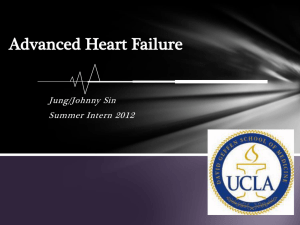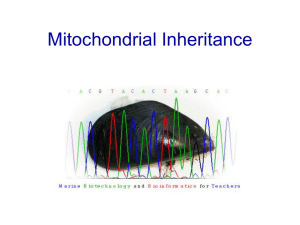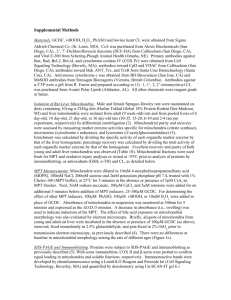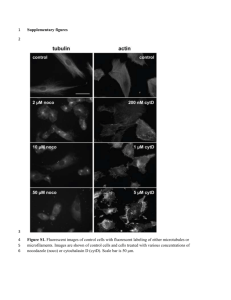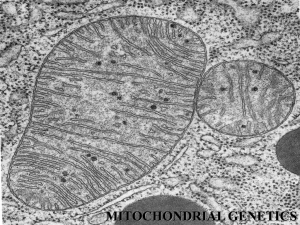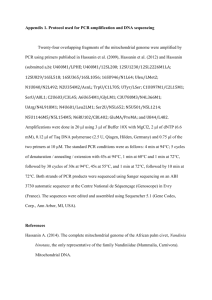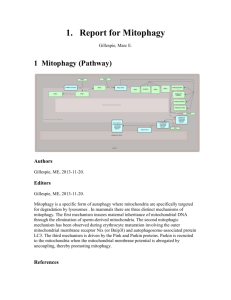Supplementary Materials and Methods
advertisement
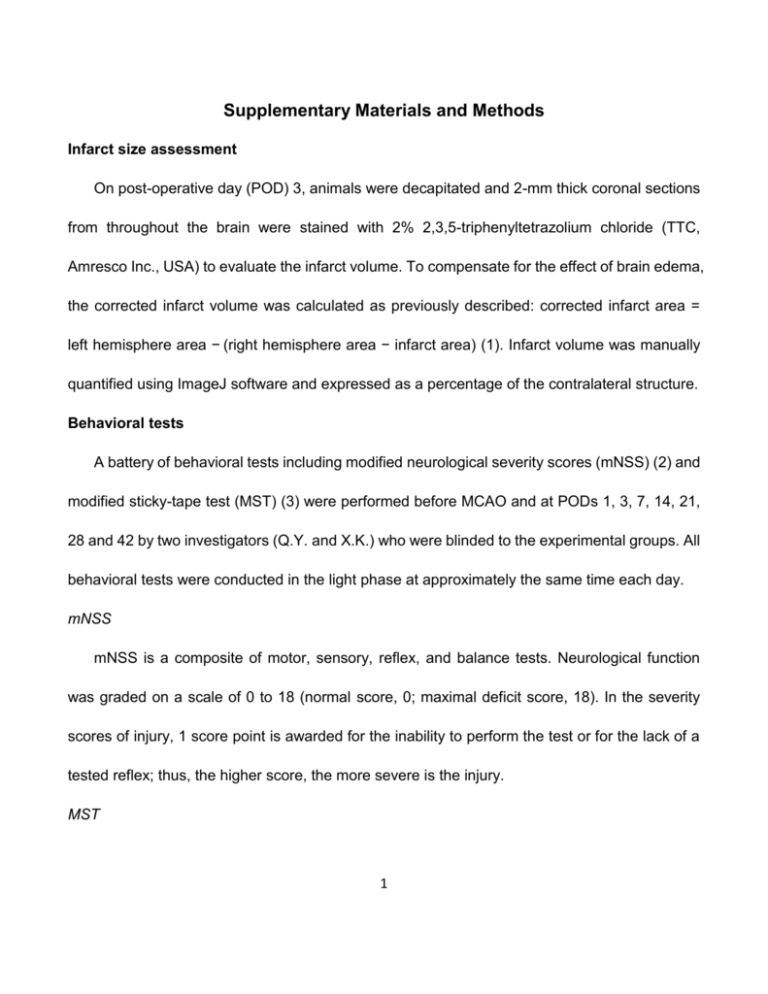
Supplementary Materials and Methods Infarct size assessment On post-operative day (POD) 3, animals were decapitated and 2-mm thick coronal sections from throughout the brain were stained with 2% 2,3,5-triphenyltetrazolium chloride (TTC, Amresco Inc., USA) to evaluate the infarct volume. To compensate for the effect of brain edema, the corrected infarct volume was calculated as previously described: corrected infarct area = left hemisphere area − (right hemisphere area − infarct area) (1). Infarct volume was manually quantified using ImageJ software and expressed as a percentage of the contralateral structure. Behavioral tests A battery of behavioral tests including modified neurological severity scores (mNSS) (2) and modified sticky-tape test (MST) (3) were performed before MCAO and at PODs 1, 3, 7, 14, 21, 28 and 42 by two investigators (Q.Y. and X.K.) who were blinded to the experimental groups. All behavioral tests were conducted in the light phase at approximately the same time each day. mNSS mNSS is a composite of motor, sensory, reflex, and balance tests. Neurological function was graded on a scale of 0 to 18 (normal score, 0; maximal deficit score, 18). In the severity scores of injury, 1 score point is awarded for the inability to perform the test or for the lack of a tested reflex; thus, the higher score, the more severe is the injury. MST 1 To assess the somatosensory dysfunction following cerebral ischemia, we performed the modified adhesive removal (sticky-tape) test. Briefly, a non-removable tape sleeve is wrapped around the animal’s paw as a tactile stimulus. When placed in a testing cage, the rats will use their mouth, and to a lesser extent the other forelimb, to attempt to remove the labels. The time spent attempting to remove the stimulus was recorded during a 30-s observation period. The test was repeated on the opposite limb until sessions consist of five trials per limb each day for a total of ten calculated ratios. The average ratio of left to right performance was calculated as the ratio of interest. Isolation of mitochondria Mitochondria were isolated according to the procedure described by Clark and Nicklas (4). Rats were decapitated and the brains were immediately removed and homogenized in an ice-cold isolation buffer (0.25 M sucrose, 1 mM K-EDTA, 10 mM Tris-HCl, pH 7.4). The homogenate was immediately centrifuged at 2000 g for 3 min, the supernatant was centrifuged again at 2000 g for 3 min, and the second supernatant was decanted and centrifuged at 12,000 g for 8 min. The supernatant was discarded and the pellet was resuspended in isolation buffer without K-EDTA. Then the suspension was centrifuged at 12,000 g for 10 min. The resulting brown mitochondrial pellet was resuspended in the same buffer. All the above procedures were carried out at 0–4 °C. Determination of mitochondrial membrane potential (MMP) and respiratory chain complexes activities 2 The ischemic core and penumbra in the ipsilateral hemisphere to the occlusion, and contralateral brain tissue were dissected at 4 h and 24 h after reperfusion as described (5-6). All the enzymatic activities were measured at 37 °C spectrophotometrically (7) by the following methods: complex I (NADH dehydrogenase) (8), complex II (succinate dehydrogenase) (9-10), complex III (ubiquinol cytochrome c reductase) (11), and complex IV (cytochrome c oxidase) (12). MMP was determined using JC-1 (Sigma, USA). Mitochondria samples (0.5 mg/ml, 1 ml) were incubated with 19 ml JC-1 staining buffer according to the manufacture’s instruction (Sigma, USA). At the end of the experiments, valinomycin was added as a negative control. Fluorescence intensity was determined at 37°C in a fluorescence spectrophotometer (Tecan, Switzerland). The ratio of aggregates (red, 590 nm) to monomer (green, 525 nm) was calculated as an indicator of MMP. Mitochondrial ROS production Mitochondrial ROS production was measured using the indicator dichlorodihydrofluorescein diacetate (H2DCFDA; Invitrogen, USA) as we described earlier (13). Opening of mPTP in isolated mitochondria Opening of mPTP was determined by Ca2+-induced mitochondrial swelling (14). The decrease in light scattering closely parallels the percentage of the mitochondrial population undergoing permeability transition. Briefly, 1 mg of isolated mitochondria was suspended in 1 ml of respiration buffer plus 10 mM succinate. After a 5-min pre-incubation at 36°C and baseline 3 measurement, CaCl2 was added to the cuvet. Mitochondrial swelling was measured as a loss of absorbance (540 nm) using a spectrometer following the addition of Ca 2+. Western blot analysis Penumbra brain samples (5) were fractionated into the cytosolic, mitochondrial, and nuclear fractions using the Pierce Mitochondrial Isolation Kit and NE-PER Nuclear and Cytoplasmic Extraction Kit (Thermo, USA) according to the manufacturer’s protocols. Western blot was performed as described before (15). We used primary antibodies to cytochrome c (CytoC; Santa Cruz, USA, 1:400), apoptosis-inducing factor (AIF; Cell Signaling, USA, 1:1000), cleaved caspase-3 (Cell Signaling, USA, 1:1000), caspase-3 (Cell Signaling, USA, 1:1000), cleaved caspase-9 (Cell Signaling, USA, 1:1000), caspase-9 (Cell Signaling, USA, 1:1000), COX IV (Abcam, UK, 1:1000), and Histone H3 (Abcam, UK, 1:2000).and β-actin (Santa Cruz, USA, 1:3000). Secondary antibodies were all purchased from GE Healthcare (Buckinghamshire, UK): peroxidase labeled anti-mouse antibody (1:5000), anti-rabbit antibody (1:10000), anti-goat antibody (1:5000). Specific signals of proteins were visualized by chemiluminescence using the ECL western blotting detection system (GE Healthcare UK). Densitometry of Western blots was analyzed with Quantity One software and normalized to respective loading control signal on each blot. 4 References 1. Lin TN, He YY, Wu G, et al. Effect of brain edema on infarct volume in a focal cerebral ischemia model in rats. Stroke 1993;24:117-121 2. Chen J, Li Y, Wang L, et al. Therapeutic benefit of intravenous administration of bone marrow stromal cells after cerebral ischemia in rats. Stroke 2001;32:1005-1011 3. Komotar RJ, Kim GH, Sughrue ME, et al. Neurologic assessment of somatosensory dysfunction following an experimental rodent model of cerebral ischemia. Nat Protoc 2007;2:2345-2347 4. Clark JB, Nicklas WJ. The metabolism of rat brain mitochondria. Preparation and characterization. J Biol Chem 1970;245:4724-4731 5. Ashwal S, Tone B, Tian HR, et al. Core and penumbral nitric oxide synthase activity during cerebral ischemia and reperfusion. Stroke 1998;29:1037-1046; discussion 1047 6. Li J, Liu W, Ding S, et al. Hyperbaric oxygen preconditioning induces tolerance against brain ischemia-reperfusion injury by upregulation of antioxidant enzymes in rats. Brain Res 2008;1210:223-229 7. Ye R, Kong X, Yang Q, et al. Ginsenoside Rd attenuates redox imbalance and improves stroke outcome after focal cerebral ischemia in aged mice. Neuropharmacology 2011;61:815-824 5 8. Estornell E, Fato R, Pallotti F, et al. Assay conditions for the mitochondrial NADH:coenzyme Q oxidoreductase. FEBS Lett 1993;332:127-131 9. Barrientos A, Kenyon L, Moraes CT. Human xenomitochondrial cybrids. Cellular models of mitochondrial complex I deficiency. J Biol Chem 1998;273:14210-14217 10. Dave KR, DeFazio RA, Raval AP, et al. Ischemic preconditioning targets the respiration of synaptic mitochondria via protein kinase C epsilon. J Neurosci 2008;28:4172-4182 11. Krahenbuhl S, Chang M, Brass EP, et al. Decreased activities of ubiquinol:ferricytochrome c oxidoreductase (complex III) and ferrocytochrome c:oxygen oxidoreductase (complex IV) in liver mitochondria from rats with hydroxycobalamin[c-lactam]-induced methylmalonic aciduria. J Biol Chem 1991;266:20998-21003 12. Wharton DC, Tzagoloff A. Isolation of an oligomycin-sensitive ATPase complex from rat liver mitochondria. Methods Enzymol 1967;55:328-333 13. Li N, Kong X, Ye R, et al. Age-Related Differences in Experimental Stroke: Possible Involvement of Mitochondrial Dysfunction and Oxidative Damage. Rejuvenation Res 2011 14. Ye R, Zhang X, Kong X, et al. Ginsenoside Rd attenuates mitochondrial dysfunction and sequential apoptosis after transient focal ischemia. Neuroscience 2011;178:169-180 15. Ye R, Yang Q, Kong X, et al. Ginsenoside Rd attenuates early oxidative damage and sequential inflammatory response after transient focal ischemia in rats. Neurochem Int 2011;58:391-398 6

